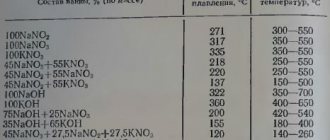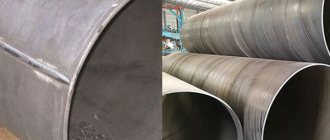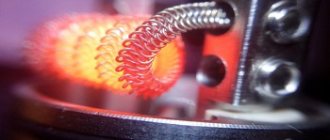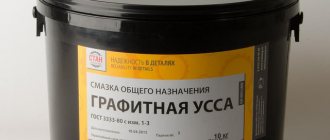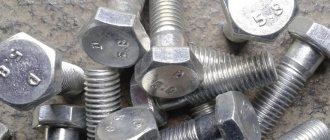Based on the consistency of lubricants, the following types can be distinguished:
- liquid, which under normal conditions of use drains from lubricated parts;
- solid (dry) are sold in solid form or in powder;
- plastic ones are a cross between the first and second materials.
We will dwell in more detail on greases and consider their properties, manufacturing features and application options.
Greases are used in those parts where regular washing of the entire friction plane is required, as well as on materials that, due to their structure, do not create the required adhesion of liquid oils.
In addition, they are ideal for processing parts during assembly of components that do not require the use of an irrigation system during operation.
Standards and GOST
Greases are one of the types of lubricants used to reduce friction and wear, increase the efficiency of mechanisms and machines, facilitate installation and dismantling, and protect the surfaces of components and parts from corrosion, oxidation and aging. For each lubricant, regulatory technical documentation (NTD) is approved: technical conditions (TU), industry standards (OST) and state standards (GOST).
In order to streamline the names and designations of lubricants, GOST 23258-78 was introduced. This document provides a name [name] for each lubricant in the form of one word, for example “litol”, etc. The name is assigned to the lubricant upon approval or revision of the technical documentation. GOST 23258-78, along with the name, establishes an alphanumeric designation, which briefly informs about the purpose, composition and main characteristics of the lubricant. The recommended temperature range for lubricant use is written as a fraction: the numerator, without the use of a minus sign, indicates the minimum temperature, and the denominator indicates the maximum operating temperature, reduced by ten times.
The minimum application temperature corresponds to a viscosity of the antifriction lubricant of about 2000 Pa•s. The maximum temperature of use for highly specialized, preservative and thread lubricants is indicated in the relevant technical documentation.
How to use intimate lubricant correctly: instructions
Lubricant gels should be used by both partners, applied to the man’s penis and to the woman’s external genitalia. If a man uses contraception, the gel is applied to the surface of the condom. Lubricants must be used strictly for their intended purpose so as not to cause irritation or allergic reactions.
| The most powerful method of penis enlargement. The penis has grown by +5.5 cm. You just need... Read more >>> |
According to general recommendations, use gel lubricant as follows:
- Detailed instructions are provided for each lubricant;
- before using the lubricant, you need to test the product for allergies (apply a little on your wrist);
- if there is no reaction, the lubricant should be applied to the skin of the genital organs of both partners;
- After the end of sexual intercourse, the remaining lubricant should be washed off with soap and water.
If suddenly there is not enough lubrication, you can reapply the product so that friction does not cause discomfort to partners. A prerequisite is to comply with the prescription of lubricants, since some of them do not accept the use of contraceptives and toys, others cannot be used daily.
Selection of greases and application table
Achieving maximum efficiency in the operation of machine mechanisms, assemblies and friction parts requires the correct choice of grease. Information about a particular lubricant specified in the specification or GOSTs, as a rule, provides only general instructions on its appropriate use, and does not take into account the real operating parameters of all elements of the system in their relationship with each other, which generally affects the overall performance and efficiency. Despite the wide range and variety of greases, each product has its own quality characteristics and features, and is designed for specific operating conditions. Informed grease selection requires extensive understanding of all associated operating parameters: temperature, loads, rotational or sliding speeds, and other operating conditions. When using grease for rolling or sliding bearings, the viscosity of the base oil is one of the most important parameters. For bearings with large diameters operating at higher sliding speeds and elevated temperatures, base oils with lower viscosity are used and vice versa. The type of thickener used determines the structure and properties of the grease: temperature stability, water resistance, dropping point, load-bearing capacity, etc. Preliminary selection of grease can be carried out using the information below and tabular data.
| Name | GOST | Operating temperature range, oC | Application area | Peculiarities |
| Graphite lubricant (“USsA”) | GOST 3333-80 | -20 … +60 | Year-round use for coarse, highly loaded friction units in low-speed mechanisms, in springs, torsion bar suspensions of tracked vehicles, in open gears, jack screws, water tap seals, as well as for threaded connections to facilitate their installation and dismantling. | Low maximum application temperature and limited mechanical stability. |
| Litol-24 | GOST 21150-2017 | -40 … +110 | In friction units of all types, in rolling and sliding bearings, hinges, gears and other transmissions, for lubrication of guides. | Multi-purpose universal lubricant with good preservative and protective properties. |
| CIATIM-221 | GOST 9433-80 | -60 … +150 | For friction units and various mechanisms without changing the lubricant, including those operating in high vacuum; lubrication of rubber O-rings and metal-to-metal and metal-to-rubber mating surfaces | Poor anti-wear properties during sliding friction, low stability in contact with aggressive media, insufficient compatibility with other types of lubricants. |
| VNII NP-207 | GOST 19774-74 | -40 … +180 | For aircraft bearings of electric machines, rolling bearings at temperatures of +150…+180°C. | Low frost resistance, tendency to heat and moisture hardening. |
| CIATIM-201 | GOST 6267-74 | -60 … +90 | In friction units of all types at low and medium specific loads (the main aviation lubricant for airplanes and helicopters), various mechanisms operating at low loads and at low temperatures. | Low maximum operating temperature and limited mechanical stability, not recommended in direct contact with water and relative humidity above 80%. |
| CIATIM-205 | GOST 8551-74 | -20 … +50 | For highly loaded mechanisms, ensuring tightness and protection from caking of contact and threaded connections, elastomeric seals. | Water resistance, sufficient stability when in contact with concentrated inorganic acids and their vapors, alkalis, alcohols, amines, etc.; not recommended for use in contact with oxygen. |
| VNII NP-242 | GOST 20421-75 | -30 … +100 | In friction units of all types, in rolling and sliding bearings, hinges, gears and other transmissions, for lubrication of guides. | Good anti-wear properties and low volatility. |
| Silicone Grease | — | -40 … +200(230) | Lightly loaded friction units, fittings, seals of threaded connections, rubber and stuffing box seals. | Wide temperature range of application, good protective properties in humid and aggressive environments, water resistance and low tendency to evaporate. |
Advantages and disadvantages
Greases used for automobiles have a number of advantages and disadvantages. Among the advantages are:
- Allows you to minimize the possibility of problems occurring during startup and stopping of friction units.
- They show better performance characteristics compared to liquid ones under pressure.
- Can be used to seal nodes.
- They effectively protect mechanisms from external pollutants.
- There are compositions with solid types of additives.
There are significantly fewer disadvantages. These include lower heat transfer rates compared to liquid ones. Therefore, their use at high operating temperatures of components is limited. The use is also limited for high-speed mechanisms, the maintenance of which is best carried out using liquid compounds.
Graphite lubricant
General purpose lubricant, a coarse, dense, homogeneous ointment of dark brown or black color with a silver tint, manufactured according to GOST 3333-80, has the old name “graphite USsA”. The composition is close to synthetic solid oils, but is prepared with a more viscous oil and contains graphite. Despite the poor low-temperature properties, it is used in rough, heavily loaded low-speed mechanisms, in springs, torsion bar suspensions of tracked vehicles, in open gears, water tap seals, as well as in threaded connections to simplify their installation and subsequent dismantling, etc. For precision mechanisms and rolling bearings, graphite lubricant is unsuitable due to the coarse grinding of graphite.
Characteristics of graft lubricant GOST 3333-80
Dropping point
≥ 77 oC Tensile strength [Pa]
300 … 700 Pa at 20oC
≥ 100 at 50oC
Viscosity [Pa•s]
1400 … 2000 Pa•s at -15oC
55 … 100 Pa•s at 0oC
60 … 100 Pa•s at 20oC
Mechanical stability [Pa]
initial tensile strength 1000-2000 Pa at 20oC Volatility [%]
2 ... 4% in 1 hour at 100oC Water washability [%]
10% in 6 hours at 40oC Extreme pressure load properties [N]
seizing 670 ... 1000 N
welding 2000 … 2500 N
Temperature range of application[ oC ]
-20oC
60oC
Main characteristics of lubricating greases
Strength
The thickener forms a unique structure, which, due to its strength, holds well on parts located obliquely or vertically.
There is a dependence that the lower the strength, the softer the material. Moreover, a limit that is too small makes the material fluid, and a limit that is too high prevents its supply to the rubbing parts.
Viscosity
An important characteristic of plastic materials, which is a variable quantity and determines their behavior in places of friction during the transition to the liquid state.
The viscosity of a material depends on how quickly deformation occurs. At high degrees of deformation, the viscosity of the lubricant decreases.
Mechanical stability
A characteristic that determines the ability of a material to retain its properties after removing the load.
It is important to take into account the fact that unstable plastic materials should not be used in assemblies where there is no tightness.
If there is a need to buy a grease, then it is important to take into account its other characteristics, such as chemical resistance, degree of adhesion, water resistance, frost resistance, and thermal stability.
Suprotek Universal-M grease for CV joints and bearings
To increase the service life and recover from wear of rolling bearings, CV joints and other components.
more reviews
Litol-24
Multi-purpose universal lubricant Litol-24 is a soft, homogeneous ointment from light yellow to brown in color, manufactured in accordance with GOST 21150-2017 by thickening a mixture of spindle AU and industrial I-50A petroleum oils in a ratio of one part to three parts with lithium soaps of 12-hydroxysteoric acid with adding additives. Like all lithium greases, it is waterproof even in boiling water. The high melting point, low volatility of the dispersed medium and sufficient tensile strength allow it to be used at temperatures up to +110 degrees Celsius. It has good frost resistance - remains operational at temperatures down to -40°C. Litol-24 ensures an increase in the period of lubrication and overhaul work, and is therefore recommended for critical friction units, sliding and rolling bearings, hinges, gears and other mechanical transmissions, as well as for lubrication of guides. It is a good choice for preserving and protecting parts from corrosion.
Characteristics of Litol-24 GOST 21150-2017
Dropping point
≥ 185 oC Tensile strength [Pa]
500 … 1000 Pa at 20oC
400 … 600 at 50oC
≥ 200 at 80oC
Viscosity [Pa•s]
900 … 1500 Pa•s at -30oC
200 … 280 Pa•s at 0oC
80 … 120 Pa•s at 20oC
Mechanical stability [Pa]
initial tensile strength 800-1400 Pa at 20oC Volatility [%]
2 ... 3% in 1 hour at 120oC Water washability [%]
3% in 6 hours at 40oC Extreme pressure load properties [N]
seizing 630 ... 800 N
welding 1600 … 2240 N
Temperature range of application [oC]
-40oC
110oC
ProductionEdit
CastingEdit
Retrieved from wikipedia
Singer Newton-John, cast at Travolta's encouragement, had done little acting before this film.
She appeared in the 1970 film Toomorrow
, a science fiction musical that predated her initial chart success with 1971's “If Not for You”.
Cast with Newton-John and three males leads in an attempt by Don Kirshner to create another Monkees, the film was never released commercially. This led Newton-John to demand a screen test for Grease
to avoid another career setback. The screen test was done with the drive-in movie scene.
Henry Winkler was once considered for a lead in the film. Winkler, who was playing Fonzie on Happy Days
, was originally chosen to play Danny, but having twice already played similarly leather-clad 1950s hoods in 1974’s
The Lords of Flatbush
as well as
Happy Days
, turned down the role for fear of being typecast, so actor John Travolta (who had recently completed
Saturday Night Fever
), was cast instead. Adult film star Harry Reems was originally signed to play Coach Calhoun;however, executives at Paramount nixed the idea due to Reems' previous work in pornography, and producers cast Sid Caesar instead. Caesar was one of several veterans of 1950s television (Eve Arden, Frankie Avalon, Joan Blondell, Edd Byrnes, Alice Ghostley, Dody Goodman) to be cast in supporting roles.
- mobil mobilux ep 2 grease
Lucie Arnaz was under serious consideration to play Rizzo, but Arnaz says she chose to keep a theater commitment due to the lack of guaranteed support from Paramount's Michael Eisner. Randal Kleiser directed Travolta (who requested him for Grease
) and Kelly Ward in
The Boy in the Plastic Bubble
two years prior to
Grease
.
FilmingEdit
Retrieved from wikipedia
The opening beach scene was shot at Malibu's Leo Carrillo State Beach, making explicit reference to
From Here to Eternity
. The exterior Rydell scenes, including the basketball, baseball, and track segments, were shot at Venice High School in Venice, California, while the Rydell interiors, including the high school dance, were filmed at Huntington Park High School. The sleepover was shot at a private house in East Hollywood. The Paramount studio lot was the location of the scenes that involve Frosty Palace and the musical numbers “Greased Lightning” and “Beauty School Dropout”. The drive-in scenes were shot at the Burbank Pickwick Drive-In (it was closed and torn down in 1989 and a shopping center took its place). The race was filmed at the Los Angeles River, between the First and Seventh Street Bridges, where many other films have been shot.The final scene where the carnival took place used John Marshall High School.
CIATIM-221
High-temperature complex calcium lubricant CIATIM-221, manufactured according to GOST 9433-80. It is a soft, homogeneous ointment with a smooth structure of white, light gray or light yellow color with a maximum application temperature of up to 150 degrees Celsius (short-term up to 180°C). It has good low-temperature properties and can be used at temperatures down to -50°C. The lubricant is insoluble in water, but is hygroscopic - when absorbing water from humid air, it tends to compact, which impairs its low-temperature properties, and therefore requires storage in an airtight container. The lubricant has poor anti-wear properties during sliding friction and is not recommended for medium- and heavily loaded sliding bearings, gearboxes and guides; its use is also not advisable in aggressive environments. Quite widely used for lubricating rubber sealing rings of pneumatic and hydraulic cylinders (in rubber-metal friction pairs). CIATIM-221 grease is chosen for operation in high vacuum from 10-1 to 10-10 Pa, where it ensures the operation of lightly and medium-loaded bearings at rotation speeds up to several thousand and temperatures up to 150 ° C for 1000 hours. Under the same conditions, at a temperature of 80°C and a rotation speed of 2500 min-1, it remains operational for several thousand hours. At a temperature of 200 degrees Celsius, the performance of the lubricant does not exceed 170-380 minutes.
Characteristics CIATIM-221 GOST 9433-80
Dropping point
≥ 200 oC Tensile strength [Pa]
250 … 450 Pa at 20oC
120 … 150 at 50oC
60 … 150 at 80oC
Viscosity [Pa•s]
450 … 750 Pa•s at -50oC
80 … 200 Pa•s at 0oC
10 … 30 Pa•s at 20oC
Mechanical stability[Pa]
initial tensile strength 30…1000 Pa at 20oC Volatility[%]
0.5…1.0% in 1 hour at 150oC Water washability[%]
2…3% in 6 hours at 40oC Extreme pressure load properties [N]
jamming 280 … 340 N
welding 1100 … 1780 N
Temperature range of application[ oC ]
-60oC
150oC
PlotEdit
Retrieved from wikipedia
In the summer of 1958, local boy Danny Zuko and vacationing Sandy Olsson meet at the beach and fall in love. When the summer comes to an end, Sandy—who is going back to Australia—frets that they may never meet again, but Danny tells her that their love is “only the beginning.” The film moves to the start of the seniors' term at Rydell High School. Danny, a greaser, is a member of the T-Birds, consisting of his best friend Kenickie, Doody, Sonny, and Putzie. The Pink Ladies also arrive, consisting of Rizzo, Frenchy, Marty, and Jan. After her parents decided not to return to Australia, Sandy enrolls at Rydell and befriends Frenchy, who considers dropping out of school to become a beautician. Oblivious to each other's presence at school, Danny and Sandy tell their respective groups the accounts of events during the pair's brief romance.
Upon learning Danny is Sandy's sweetheart, Rizzo arranges for the two to reunite, but Danny is forced to maintain his bad-boy attitude in front of his pals, upsetting Sandy. Frenchy invites the girls to a pajama party, but Sandy falls ill from trying a cigarette and drinking. The T-Birds almost crash the party in Kenickie's Greased Lightning car, but a guilty Danny leaves, followed by Rizzo, who departs to make out with Kenickie, who is actually her boyfriend. The two are disturbed by Leo, leader of the T-Birds' rival gang, the Scorpions, and his girlfriend Cha-Cha, leading to a planned race between Kenickie and Leo. Wishing to win his way back into Sandy's affection, Danny turns to Coach Calhoun to get into sports, eventually becoming a runner. He reunites with Sandy and they attempt to go on a date, but their friends crash it, resulting in Kenickie and Rizzo arguing and parting. Left alone, Frenchy is visited by a guardian angel who advises her to return to school after a mishap in beauty class leaves her with candy-pink hair.
The school dance arrives, broadcast live on television and hosted by DJ Vince Fontaine, who flirts with Marty. Rizzo and Kenickie attempt to spite one another by bringing Leo and Cha-Cha as their dates, while Danny and Sandy come together. Kenickie humiliates Patty Simcox by lifting her dress up in front of the whole school. During a dance, Danny and Cha-Cha (who were once boyfriend and girlfriend) perform together and win a dance-off. Danny tries to make it up to Sandy by taking her to a drive-in theater but ends up making several passes on her, causing Sandy to flee. Meanwhile, Rizzo fears she is pregnant after missing a period and confides to Marty, but Sonny overhears and spreads the rumor which eventually reaches Kenickie who is the potential father.
The race arrives, but Kenickie is knocked out by his own car door thanks to the careless behavior of his friend Putzie, so Danny takes up the challenge. He and Leo race until Leo crashes and leaves humiliated, with Danny as the victor. Sandy watches from afar, concluding she still loves Danny and decides to change her attitude and look to impress him. On the last day of school, while Principal McGee and her assistant Blanche sob about the departing class, the class celebrates their graduation at the fair on the school grounds. Rizzo discovers she is not pregnant after all and reunites with Kenickie. Danny has become a jock, but is shocked when Sandy appears dressed in leather and is seen smoking. In song, the two admit they love each other and reunite. The film ends with Danny and Sandy departing in the Greased Lightning car together, which then takes flight, and the pair waves goodbye to their friends. The film ends with credits in the style of a yearbook. This is extremely effective and leaves us hungry for a seque.
VNII NP-207
High-temperature special lubricant, similar in composition and properties to CIATIM-221 lubricant. VNII NP-207 grease is manufactured in accordance with GOST 19774-74 by thickening a mixture of organosilicon grease 135-25 with MAS-35 oil and adding antioxidant additives, which improves thermal-oxidative stability. VNII NP-207 grease significantly exceeds CIATIM-221 grease in terms of service life in rolling bearings (aviation and electrical machines) with rotation speeds up to 10,000 min-1 at temperatures of 150-180°C (short-term overheating up to 200°C is allowed). It has a higher viscosity at low temperatures and is therefore inferior in frost resistance to CIATIM-221 lubricant. The presence of synthetic hydrocarbon oil in the lubricant causes increased swelling when some brands of rubber come into contact with it.
Characteristics of VNII NP-207 GOST 19774-74
Dropping point
≥ 250 oC Tensile strength [Pa]
250 … 500 Pa at 20oC
200 … 250 at 50oC
70 … 110 at 80oC
Viscosity [Pa•s]
600 … 1400 Pa•s at -50oC
180 … 200 Pa•s at 0oC
80 … 100 Pa•s at 20oC
20 … 55 Pa•s at 20oC
Mechanical stability [Pa]
initial tensile strength 150...1000 Pa at 20oC Volatility [%]
4...9% in 1 hour at 200oC Water washability [%]
0% in 6 hours at 40oC Extreme pressure load properties [N]
seizing 420 ... 1000 N
welding 1580 … 2000 N
Temperature range of application [oC]
-40oC
180oC
CastEdit
Retrieved from wikipedia
Lead
- John Travolta as Danny Zuko
- Olivia Newton-John as Sandy Olsson
T-Birds
- Jeff Conaway as Kenickie
- Barry Pearl as Doody
- Michael Tucci as Sonny
- Kelly Ward as Putzie
Pink Ladies
- Stockard Channing as Betty Rizzo
- Didi Conn as Frenchy
- Jamie Donnelly as Jan
- Dinah Manoff as Marty Maraschino
Students
- Eddie Deezen as Eugene Felsnic
- Susan Buckner as Patty Simcox
- Lorenzo Lamas as Tom Chisum
- Dennis C. Stewart as Leo Balmudo
- Annette Charles as Charlene DiGregorio
School staff
- Eve Arden as Principal McGee
- Dody Goodman as Blanche Hodel
- Sid Caesar as Coach Calhoun
- Alice Ghostley as Mrs. Murdock
- Darrell Zwerling as Mr.Lynch
- Dick Patterson as Mr. Rudie
Other
- Joan Blondell as Vi
- Ellen Travolta as Waitress
- Frankie Avalon as Teen Angel
- Edd Byrnes as Vince Fontaine
- Sha-Na-Na as Johnny Casino & The Gamblers
CIATIM-201
The main frost-resistant refractory lubricant is a soft lump-free ointment from light yellow to light brown in color, produced in accordance with GOST 6267-74. Due to the high volatility of the dispersed medium, CIATIM-201 lubricant is used at temperatures no higher than 80...90 degrees Celsius. In many mechanisms it remains operational when the temperature drops to -60°C. Due to its soft consistency and lack of stickiness, it can be mechanically washed off from exposed surfaces, so it is not recommended for protecting the surfaces of parts from corrosion.
Characteristics CIATIM-201 GOST 6267-74
Dropping point
≥ 175 oC Tensile strength [Pa]
350 … 500 Pa at 20oC
250 … 500 at 50oC
130 … 250 at 80oC
Viscosity [Pa•s]
600 … 1000 Pa•s at -50oC
80 … 170 Pa•s at 0oC
45 … 120 Pa•s at 20oC
Mechanical stability[Pa]
initial tensile strength 600…1500 Pa at 20oC Volatility[%]
10…12% in 1 hour at 100oC Water washability[%]
10…25% in 6 hours at 40oC Extreme pressure load properties[N]
seizing 250 … 500 N
welding 1000 … 1580 N
Temperature range of application[ oC ]
-60oC
90oC
CIATIM-205
The most widespread chemically resistant hydrocarbon lubricant CIATIM-205 is a homogeneous vaseline-like dense oily ointment from white to light cream color, manufactured in accordance with GOST 8551-74 by thickening a mixture of highly purified viscous oils (medical petroleum jelly and perfume) with white ceresin. The lubricant is highly water resistant and is designed to seal and prevent caking of contact and threaded connections, as well as seals in contact with aggressive media. In threaded and fixed connections it ensures tightness at temperatures from -60 to 50°C.
Characteristics CIATIM-205 GOST 8551-74
Dropping point
≥ 65 oC Tensile strength [Pa]
1200 Pa at 20oC
400 … 800 Pa at 50oC
0 Pa at 80oC
Viscosity [Pa•s]
2000 … 6000 Pa•s at -15oC
1000 … 1500 Pa•s at 0oC
100 … 300 Pa•s at 20oC
Mechanical stability [Pa]
initial tensile strength > 5000 Pa at 20oC Volatility [%]
10...12% in 1 hour at 100oC Water washability [%]
1% in 6 hours at 40oC Extreme pressure load properties [N]
seizing 500 N
welding 1250 N
Temperature range of application [oC]
-20oC
50oC
VNII NP-242
A homogeneous soft ointment of black color [with the addition of 2% molybdenum disulfide MoS2], manufactured in accordance with GOST 20421-75, its properties are close to multi-purpose lubricant. VNII NP-242 grease is water-resistant, has low volatility, good anti-wear properties and poor mechanical stability. It is mainly used in bearings of horizontal marine electrical machines. The service life at a temperature of 60...80°C and a rotation speed of 1500-3000 min-1 reaches 10,000-24,000 hours.
Characteristics of VNII NP-242 GOST 20421-75
Dropping point
≥ 170 oC Tensile strength [Pa]
500…1200 Pa at 20oC
250 … 650 Pa at 50oC
≥100 Pa at 80oC
Viscosity [Pa•s]
800 … 1600 Pa•s at -20oC
200 … 400 Pa•s at 0oC
140 … 240 Pa•s at 20oC
Mechanical stability [Pa]
initial tensile strength 1000...2000 Pa at 20oC Volatility [%]
oC Water washability [%]
3.5% in 6 hours at 40oC Extreme pressure load properties [N]
seizing 700 N
welding 2250 N
Temperature range of application [oC]
-30oC
100oC
What other NLGI 2 lubricants are there?
Brands and varieties of materials of this class are produced by modern industry, thus there are many. Of course, most often these are lubricants intended for various industrial mechanisms, special equipment and cars. But today there are also products in this category intended for use in food equipment.
Castrol lmx: lubricant characteristics, application, reviews
An example of such a material is NLGI 2 SKF LGFP 2 grease. This non-toxic product is made from white medicinal oil using aluminum complex soap. Such material, among other things, is food compatible.
SKF LGFP 2 grease can be used, for example:
- in equipment for bakeries;
- Multi-pack cassette bearings;
- packaging machines;
- in filling machines;
- bearings of conveyors of food industry enterprises.
The advantages of this lubricant, among other things, include a high degree of water resistance and long service life. A big advantage of this material is also its neutral pH value.
Silicone Grease
Plastic silicone grease is a homogeneous, ointment-like substance of transparent or transparent white color, has high water-repellent, preservation, sealing and anti-friction properties (name MS-Sport [with the addition of fluoroplastic], Silicot, Liqui Moly Silicon-Fett, etc.) , as well as high temperature stability and aging resistance. Applicable for lightly loaded sliding and rolling friction: for rolling and sliding bearings, locking and hinge mechanisms, valve fittings and threaded connections, guides and rubber seals (rubber rings and cuffs), as a sealing lubricant in labyrinth seals. Due to the flat viscosity-temperature curve [low temperature coefficient of viscosity], thermal and chemical stability, it has a wide operating temperature range from -50 to +200°C [short-term up to 230 degrees Celsius]. Silicone grease shows good protective properties in humid or aggressive environments, does not stain and has a low tendency to evaporate? increases service life and provides high-quality protection for rubber seals.
Composition and dosages
Materials of this type are usually made on the basis of ISOSIN base oils. They may also contain the following ingredients:
Which syringe for changing gearbox oil should you buy?
- lithium or inorganic thickeners;
- oxidation inhibitors;
- adhesive and extreme pressure additives.
The color of materials in this class, depending on the brand, may be brown, yellow or blue.
Of course, such oils should be used in mechanisms in sufficient quantities to reduce friction. The dosage of NLGI 2 oils depends on the specific unit in which they are used. When using such means in this regard, you should be guided, first of all, by the passport and recommendations from the manufacturer of this particular device.
Greases of this type are designated by the abbreviation NLGI - from the name National Lubricating Grease Institute. After the letters in the marking there is a number 2 - a specific class of material.

